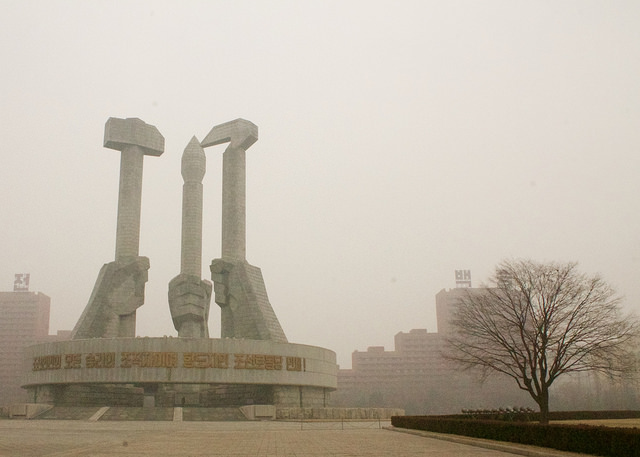
North Korea’s nuclear weapon and long-range missile programs are gathering momentum, according to a US Defense Intelligence Agency report,
commented on by the
Washington Post. The
Post story suggests that North Korea has successfully produced a miniaturised nuclear warhead that can fit inside its ballistic missiles, including the intercontinental ballistic missiles (ICBMs) that it has tested twice. The story also suggests that Pyongyang has up to 60 nuclear weapons, considerably more than previously thought. In recent days, North Korea has alluded to planning for attacks on
Guam, and President Trump has responded by
stating that North Korea ‘will be met with fire and fury like the world has never seen’. The rhetoric and the threats are reaching a crescendo on both sides, and the crisis becomes more dangerous by the day.
If North Korea has in fact miniaturised a nuclear warhead to fit on its ICBMs, then the Trump administration has
failed to prevent North Korea from having the ability to
threaten the US with nuclear weapons.
An article on the highly reputable North Korean analysis site 38 North suggests that North Korea may still have to iron out the technical challenges of its warheads surviving re-entry into the earth’s atmosphere if it is to deliver a warhead with accuracy. Overcoming those challenges might be the final step before it could practically threaten the US with nuclear attack. But it’s very clear that North Korea is making much faster progress than anticipated. Arms Control Wonk’s Jeffrey Lewis is
blunt: ‘The reality is that the United States is now vulnerable to North Korea’s nuclear-armed missiles—and has no choice but to live with that reality.’
If that’s the case, the US would need to visibly and meaningfully strengthen deterrence against Pyongyang. That could be done concurrently in three different ways. First, the Trump administration must explicitly strengthen its security guarantee of extended nuclear deterrence to South Korea, Japan and Australia as a priority and communicate that resolve to Pyongyang in the strongest possible terms. There should be no doubt left in Kim Jong-un’s mind that US nuclear retaliation against North Korea would swiftly follow any actual North Korean nuclear attack against South Korea, Japan or Australia, or against US territory.
A strengthened deterrence posture may involve the US re-evaluating the role of theatre-tactical nuclear forces for the first time since the Cold War. Forward deployment of such forces onto the Korean peninsula, or returning them to US Navy ships and submarines in PACOM, would be a visible signal of resolve that Pyongyang could not ignore. Greater investment in ground- and space-based missile early warning and tracking would add to that enhanced deterrence. It could also strengthen ballistic missile defence (BMD). In that way, deterrence through threat of retaliation could be complemented by deterrence by denial as a second approach to quieting Pyongyang.
In that regard, Australia needs to get serious about developing an effective theatre BMD capability through acquiring SM-3 interceptors for its air warfare destroyers. The AWDs are getting an update to their Aegis combat systems in the 2020s that would enable them to operate the SM-3, so not having the missiles makes little sense. Systems like SM-3 and THAAD are most effective against short-range or medium-range missiles, and potentially intermediate-range missiles at a pinch. Therefore the objective for Australia in supporting deterrence by denial against North Korea would be to undermine the effectiveness of any North Korean nuclear threat against Seoul or Tokyo. Australia would continue to remain dependent on US extended nuclear deterrence security guarantees, and should take steps to strengthen those guarantees by hosting additional US forces and facilities where appropriate.
A third approach open to the US and its allies for deterring North Korea’s nuclear threat is to invest in greater capability to strike DPRK nuclear forces swiftly and effectively with precision conventional forces to prevent North Korea from using its nuclear weapons. North Korean land-based missiles are increasingly mobile and solid-fuelled, and Pyongyang is beginning to develop a submarine-based assured second strike capability. So while non-nuclear strikes may not catch all North Korean nuclear forces on the ground, they could reduce the number launched sufficiently to make an enhanced regional BMD capability more effective. Such a precision strike capability could also be targeted against command and control and key leadership, which would add to deterrence against a regime that values its own survival above all else. With the weakening of the INF Treaty as a result of alleged Russian cheating, a
case could be made for South Korea and Japan to acquire the very prompt strike options needed to rapidly deal with North Korean missiles before they can be launched.
Denuclearisation of North Korea has failed, but that doesn’t mean we should be throwing our collective hands in the air and doing nothing while North Korea rattles its ever-growing number of nuclear sabres. A stronger deterrence posture based on a combination of retaliation, denial and a precision strike capability should be a clear policy option for the US and its allies, including Australia.
 Print This Post
Print This Post